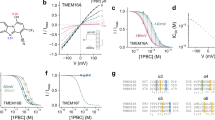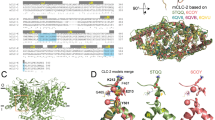Abstract
STIMULATION of β-adrenoceptors in cardiac ventricular myocytes activates a strong chloride ion conductance1–5 as a result of phosphorylation by cyclic AMP-dependent protein kinase (PKA)2,4. This Cl− conductance, which is time- and voltage-independent1,5, counters2,5 the tendency of the simultaneously enhanced Ca2+ channel current to prolong the ventricular action potential. Using inside-out giant patches6 excised from guinea-pig myocytes, we show here that phosphorylation by the PKA catalytic subunit plus Mg-ATP elicits discrete Cl− channel currents. In almost symmetrical Cl− solutions (∼150 mM), unitary current amplitude scales with membrane potential, and reverses sign near 0 mV, to yield a single channel conductance of ∼12 pS. Opening of the phosphorylated channels requires hydrolysable nucleoside triphosphate, indicating that phosphorylation by PKA is necessary, but not sufficient, for channel activation. The properties of these PKA-regulated cardiac Cl− channels are very similar, if not identical, to those of the cystic fibrosis transmembrane conductance regulator (CFTR)7, the epithelial cell Cl− channel whose regulation is defective in patients with cystic fibrosis. The full cardiological impact of these Cl− channels and of their possible malfunction in patients with cystic fibrosis remains to be determined.
This is a preview of subscription content, access via your institution
Access options
Subscribe to this journal
Receive 51 print issues and online access
$199.00 per year
only $3.90 per issue
Buy this article
- Purchase on Springer Link
- Instant access to full article PDF
Prices may be subject to local taxes which are calculated during checkout
Similar content being viewed by others
References
Harvey, R. D. & Hume, J. R. Science 244, 983–985 (1989).
Bahinski, A., Nairn, A. C., Greengard, P. & Gadsby, D. C. Nature 340, 718–721 (1989).
Matsuoka, S., Ehara, T. & Noma, A. J. Physiol., Lond. 425, 579–598 (1990).
Hwang, T.-C., Horie, M., Nairn, A. C. & Gadsby, D. C. J. gen. Physiol. 99, 465–489 (1992).
Harvey, R. D., Clark, C. D. & Hume, J. R. J. gen. Physiol. 95, 1077–1102 (1990).
Hilgemann, D. W. Nature 344, 242–245 (1990).
Riordan, J. R. et al. Science 245, 1066–1073 (1989).
Ehara, T. & Ishihara, K. Nature 347, 284–286 (1990).
Cheng, H.-C. et al. J. biol. Chem. 261, 989–992 (1986).
Tabcharani, J. A., Chang, X.-B., Riordan, J. R. & Hanrahan, J. W. Nature 352, 628–631 (1991).
Berger, H. B. et al. J. clin. Invest. 88, 1422–1431 (1991).
Kartner, N. et al. Cell 64, 681–691 (1991).
Anderson, M. P. et al. Cell 67, 775–784 (1991).
Anderson, M. P., Rich, D. R., Gregory, R. J., Smith, A. E. & Welsh, M. J. Science 251, 679–682 (1991).
Cheng, S. H. et al. Cell 66, 1027–1036 (1991).
Overholt, J. L. & Harvey, R. D. Biophys. J. 61, A442 (1992).
Anderson, M. P. et al. Science 253, 202–205 (1991).
Hwang, T.-C., Horie, M., Dousmanis, A. G. & Gadsby, D. C. J. gen. Physiol. 100, 69a (1992).
Cliff, W. H., Schoumacher, R. A. & Frizzell, R. A. Am. J. Physiol. 262, C1154–C1160 (1992).
Yoshimura, K. et al. Nucleic Acids Res. 19, 5417–5423 (1991).
Vincent, G. M., Abildskov, J. Z. & Burgess, M. J. Prog. Cardiovasc. Dis. 16, 523–530 (1974).
Benson, L. N. et al. Am. Rev. Respir. Dis. 130, 987–992 (1984).
Chéron, G., Paradis, K., Stéru, D., Demay, G. & Lenoir, G. Acta paediatr. scand. 73, 697–700 (1984).
Sullivan, M. M., Moss, R. B., Hindi, R. D. & Lewiston, N. J. Chest 90, 239–242 (1986).
Hilgemann, D. W., Nagel, G. A. & Gadsby, D. C. in The Sodium Pump: Recent Developments (eds Kaplan, J. H. & De Weer, P.) 543–547 (Rockefeller Univ. Press, New York, 1991).
Kaczmarek, L. Y. et al. Proc. natn. Acad. Sci. U.S.A. 77, 7487–7491 (1980).
Chirgwin, J. M., Przybyla, A. E., MacDonald, R. J. & Rutter, W. J. Biochemistry 18, 5294–5299 (1979).
Sambrook, J., Fritsch, E. F. & Maniatis, T. Molecular Cloning: A Laboratory Manual (Cold Spring Harbor Laboratory Press, New York, 1989).
Amasino, R. M. Analyt. Biochem. 152, 304–307 (1986).
Church, G. M. & Gilbert, G. Proc. natn. Acad. Sci. U.S.A. 81, 1991–1995 (1984).
Author information
Authors and Affiliations
Rights and permissions
About this article
Cite this article
Nagel, G., Hwang, TC., Nastiuk, K. et al. The protein kinase A-regulated cardiac CI− channel resembles the cystic fibrosis transmembrane conductance regulator. Nature 360, 81–84 (1992). https://doi.org/10.1038/360081a0
Received:
Accepted:
Issue Date:
DOI: https://doi.org/10.1038/360081a0
This article is cited by
-
Hormone-regulated PKA activity in porcine oviductal epithelial cells
Cell and Tissue Research (2020)
-
Sites associated with Kalydeco binding on human Cystic Fibrosis Transmembrane Conductance Regulator revealed by Hydrogen/Deuterium Exchange
Scientific Reports (2018)
-
Fast manipulation of cellular cAMP level by light in vivo
Nature Methods (2007)
Comments
By submitting a comment you agree to abide by our Terms and Community Guidelines. If you find something abusive or that does not comply with our terms or guidelines please flag it as inappropriate.



